Day Trip to ArtCologne Review
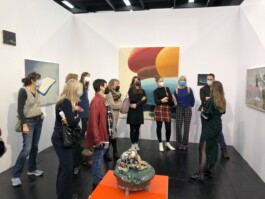
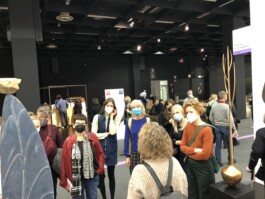
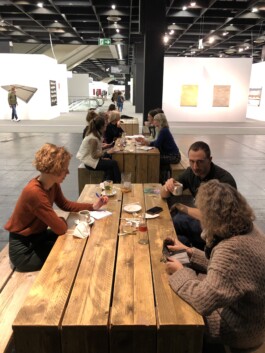
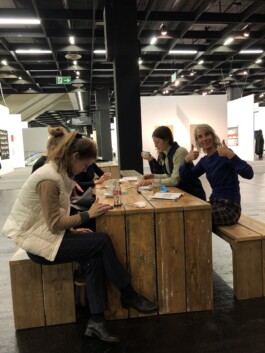
How do art markets work – nationally, internationally and in the BORDERLANDS specifically? A look behind the scenes at ArtCologne, featuring Akinci Gallery (Amsterdam), Löhrl Gallery (Mönchengladbach) and MOFF magazine (Cologne).
In the past few months of BORDERLAND RESIDENCIES, we have been confronted with the different functionalities of the art markets in the Netherlands and Germany. Between trying to find a gallery to exhibit one’s work and participating in residency programmes; guest shows at institutions; and actually presenting work at a museum or selling to a museum – or, in Germany, also to a Kunstverein –, there are multiple ways of promoting oneself as an artist. The personal approach to art and the self-conception as an artist oftentimes define the spaces in which art is produced and received. Whether someone’s art is more conceptual; interacts with the environment and people; follows a participative approach; focuses on aesthetic criteria; or is temporary or meant to last, influences the contexts of where art is shown and whether or not it is considered „sellable“ – to whomsoever.
Akinci Gallery (Amsterdam) is trying to open up specifically to postgraduates, acknowledging that young artists fresh off the academies often struggle with how to approach galleries. They suggest not to contact galleries randomly or at fairs, but to look into their portfolio beforehand: Does the gallery fit an artist’s own artistic method, topics and aesthetics? A well-founded motivation often leaves a positive impression with the gallery owners. But once Akinci commits to representing an artist, they have got their backs: they organize their marketing, help with the storage of their artworks and counsel them on their pricing. This was also their final advice: don't start out too expensive. It is better to raise prices over time than to lower them. In the beginning, it is important to sell as much as possible in order to become better known.

This is exactly what the internationally renowned Galerie Löhrl (Möchengladbach) advises, which offers a complex career system for its up-and-coming artists.
While in the early years it was still a scout in academies and off-rooms, it now selects young positions strictly within the framework of its established art profile. The gallery offers its artists an international network of cooperating galleries, which contribute significantly to securing their market presence and thus to securing their long-term existence. Löhrl Jr. recommends that BORDERLAND fellows distinguish themselves through high artistic quality and, above all, commitment – the rest is a matter of luck...
And he reminds us once again how difficult it is, even with the support of a gallery, to live from art alone. Even if the career has a promising start, most artists experience a slump in their mid-30s at the latest.
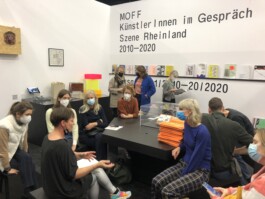
A completely different approach was presented at MOFF (Köln), an art magazine and collective that aims at being an off-space (M for “magazine” + OFF for “off-space” = MOFF) for art dialogue and collaborative practice.
Since the participating artists of MOFF change from issue to issue, MOFF is a fluid construct that has used that flow as an ability to morph that has made them resilient throughout the ups and downs of the years. MOFF also focuses on art works that interact with social structures and that include people into the project, breaking their work down to the one essential question: When art is not seen, is it even really there?
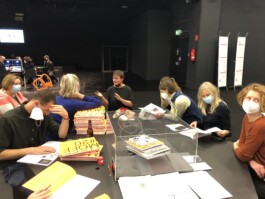
The trip to ArtCologne has proven that there is a variety of artistic positions, self-promoting and positioning on a commercial art market. The specific mechanisms of the Dutch and German art scenes have shown distinctive characteristics of each side of the border. Thank you Akinci Gallery, Löhrl Gallery and MOFF magazine for the exclusive insights!
Day Trip to ArtCologne Review




How do art markets work – nationally, internationally and in the BORDERLANDS specifically? A look behind the scenes at ArtCologne, featuring Akinci Gallery (Amsterdam), Löhrl Gallery (Mönchengladbach) and MOFF magazine (Cologne).
In the past few months of BORDERLAND RESIDENCIES, we have been confronted with the different functionalities of the art markets in the Netherlands and Germany. Between trying to find a gallery to exhibit one’s work and participating in residency programmes; guest shows at institutions; and actually presenting work at a museum or selling to a museum – or, in Germany, also to a Kunstverein –, there are multiple ways of promoting oneself as an artist. The personal approach to art and the self-conception as an artist oftentimes define the spaces in which art is produced and received. Whether someone’s art is more conceptual; interacts with the environment and people; follows a participative approach; focuses on aesthetic criteria; or is temporary or meant to last, influences the contexts of where art is shown and whether or not it is considered „sellable“ – to whomsoever.
Akinci Gallery (Amsterdam) is trying to open up specifically to postgraduates, acknowledging that young artists fresh off the academies often struggle with how to approach galleries. They suggest not to contact galleries randomly or at fairs, but to look into their portfolio beforehand: Does the gallery fit an artist’s own artistic method, topics and aesthetics? A well-founded motivation often leaves a positive impression with the gallery owners. But once Akinci commits to representing an artist, they have got their backs: they organize their marketing, help with the storage of their artworks and counsel them on their pricing. This was also their final advice: don't start out too expensive. It is better to raise prices over time than to lower them. In the beginning, it is important to sell as much as possible in order to become better known.

This is exactly what the internationally renowned Galerie Löhrl (Möchengladbach) advises, which offers a complex career system for its up-and-coming artists.
While in the early years it was still a scout in academies and off-rooms, it now selects young positions strictly within the framework of its established art profile. The gallery offers its artists an international network of cooperating galleries, which contribute significantly to securing their market presence and thus to securing their long-term existence. Löhrl Jr. recommends that BORDERLAND fellows distinguish themselves through high artistic quality and, above all, commitment – the rest is a matter of luck...
And he reminds us once again how difficult it is, even with the support of a gallery, to live from art alone. Even if the career has a promising start, most artists experience a slump in their mid-30s at the latest.

A completely different approach was presented at MOFF (Köln), an art magazine and collective that aims at being an off-space (M for “magazine” + OFF for “off-space” = MOFF) for art dialogue and collaborative practice.
Since the participating artists of MOFF change from issue to issue, MOFF is a fluid construct that has used that flow as an ability to morph that has made them resilient throughout the ups and downs of the years. MOFF also focuses on art works that interact with social structures and that include people into the project, breaking their work down to the one essential question: When art is not seen, is it even really there?

The trip to ArtCologne has proven that there is a variety of artistic positions, self-promoting and positioning on a commercial art market. The specific mechanisms of the Dutch and German art scenes have shown distinctive characteristics of each side of the border. Thank you Akinci Gallery, Löhrl Gallery and MOFF magazine for the exclusive insights!